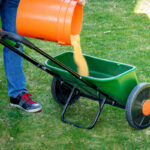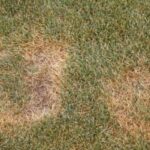
Overfertilizing your lawn can quickly turn a green, vibrant yard into a patchy mess. Learn the 5 simple steps to fix an over-fertilized lawn, from removing the extra fertilizer to watering the lawn to planting new grass. Learn everything you need to bring your lawn back to life.
5 Steps to Repair an Over-Fertilized Lawn

Over-fertilizing your lawn can lead to fertilizer burn, a condition where the grass turns brown or yellow due to excessive nutrients. This impacts your lawn’s appearance and weakens its health making it more vulnerable to pests, diseases, and stress. Fortunately, with the right approach, an over-fertilized lawn can be repaired. Here are five steps to help restore its beauty.
1. Remove Extra Fertilizer
The first step in fixing an over-fertilized lawn is to remove as much as you can of the excess fertilizer as you can. If you notice a heavy spill in one spot, especially with granular fertilizer, act quickly. Use a rake to gather clumps and a broom to sweep up the smaller pieces.
The faster you can clean up the extra fertilizer, the better chance your lawn has to recover without lasting damage!
2. Water Your Lawn
The second step is to deeply water the affected areas with about an inch of water daily fro two weeks. Extra water helps dilute and wash away the excess fertilizer, flushing out the salts that can harm your grass. This gives the roots a chance to recover and regain their strength.
For best results, water your lawn as soon as you realize you’ve over-fertilized. But even if you start noticing browning or yellowing, watering can still help your lawn recover and bounce back.
3. Assess Damage
Check the grass blades: Are only the tips burned, or do the roots seem affected, too? If the roots are still strong, your lawn has a good chance of recovering. But if the roots are dry, crunchy, and pull up easily, they might be dead. In that case, you’ll need to prepare your lawn for planting new grass.
4. Prepare Ground for New Grass

If you need to plant new grass, the first thing to do is prepare the ground. Start by raking away the dead grass. Once the area is cleared, water it for about a week to flush out any leftover salts from the fertilizer.
Aerating the soil can also help by improving water and nutrient absorption. It loosens up the ground and makes it easier for new roots to grow. You can also do a soil test. Since the lawn was recently over-fertilized, the results may show unbalanced nutrient levels. If so, you need to amend the soil to correct the imbalances before planting grass seed.
5. Plant New Grass
The final step in fixing an over-fertilized lawn is to plant new grass. Depending on how large the damaged areas are, you can either reseed or lay new sod. For smaller patches, reseeding is usually the easiest option. But if larger sections of your lawn are affected, laying sod might be quicker and it gives immediate results.
If you decide to go with sod, make sure it’s pressed firmly into the ground so the roots can take hold. For reseeding, follow the proper steps to overseed and ensure the seeds settle into the soil and get the nutrients they need to grow.
FAQ About Over-Fertilized Lawns
Can an over-fertilized lawn recover?
Yes, an over-fertilized lawn can recover in one or two weeks, as long as the roots are still alive. By following the steps in this guide, such as removing excess fertilizer, watering generously, and giving your grass time to heal, you can help it bounce back. If you’re unsure or need extra help, a lawn care professional can offer support on your lawn recovery.
Is it dangerous to use too much fertilizer?
Yes, using too much fertilizer can be harmful. Excess fertilizer damages your lawn and contributes to environmental pollution. The leftover amounts can seep into the soil, water, and air, causing harm to local ecosystems.
Is slow-release better than quick-release fertilizer to avoid fertilizer burn?
Yes, slow-release fertilizer is better for avoiding fertilizer burn. It provides nutrients gradually, promoting long-term lawn health.
When to Call a Pro
Over-fertilizing is a common mistake that can happen to anyone, but the key is to act quickly to help your lawn recover. By following the steps in this guide, you can bring your grass back to life and get it looking healthy again.
If you find the process overwhelming or need help, contact a lawn care professional. They can assess the damage for you and recommend the best treatment options.
Main Photo Credit: Scot Nelson / Flickr





